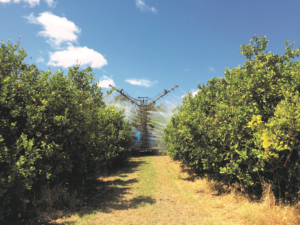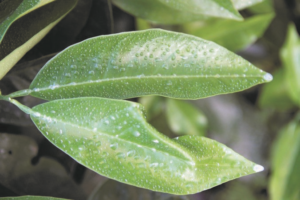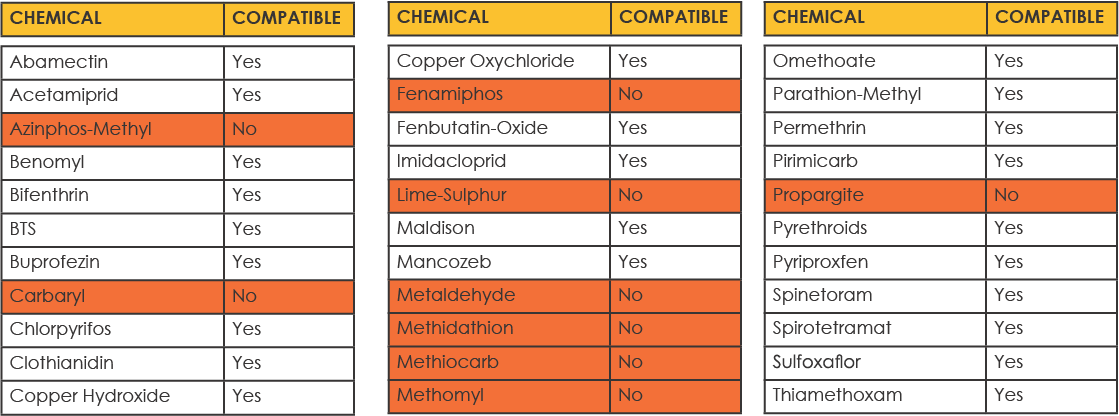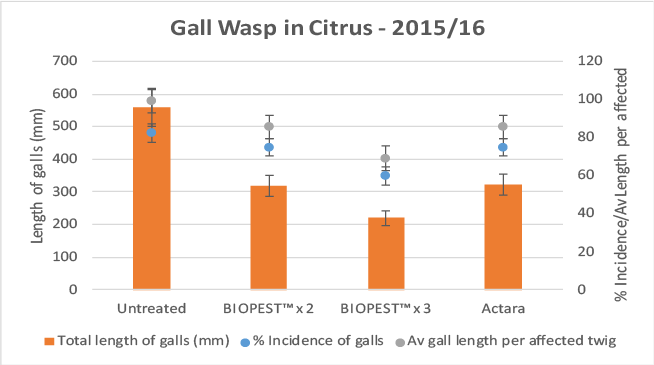
BIOPEST IN ORCHARDS
| Version 3 | Date November 2020 | Reference 61 |
BIOPEST™ has been the product of choice for pest control in many orchards for over a decade, with many unique characteristics including;
- Safe to beneficials – particularly pollinators, perfect IPM fit.
- Organically certified – with no residue issues.
- No risk of resistance development – due to unique physical and behaviour modification actions.
- Pure and optimal weight oil – highest level of refining possible means less risk of crop damage, whilst maintaining high levels of pest control.
- Extensive label for a wide range of tree crops and situations.
- Compatible with a number of products including foliar fertilisers – backed by ongoing field evaluation.
Orchard practices continue to change significantly with updated application technologies, removal of broad spectrum insecticides, the increased use of foliar fertilisers and export markets requiring IPM production practices. SACOA continue to invest heavily in research to keep abreast of these changes and provide BIOPEST™ users with the best advice around product usage. Over the last 18 months SACOA have conducted field work investigating the following;
- Proving crop safety of BIOPEST™ with foliar fertilisers in citrus.
- Evaluating BIOPEST™ for control of mites mid-season in almonds.
- Evaluating BIOPEST™ for gall wasp control in citrus.
- Proving crop safety of BIOPEST™ in standard insecticide programs in avocados and macadamias.
When using BIOPEST™ for pest control, the following guidelines should be followed to maximise pest control and minimise the risk of crop damage.
- Targeting the correct pest stage is crucial
Applications to control scale should be made when the 1st instar or crawler stage are visible. Controlling ants at the same time is critical for optimal results (see Figure 1). Set pest thresholds, monitor and spray when necessary (see Table 1 for optimal pest timing). Consider multiple applications if required. - Coverage is crucial
Use high water volumes with air assist to ensure thorough coverage through the canopy. Water rates should reflect the type of equipment being used and the tree size, to get optimal coverage (see Figure 2). In addition, regular calibration of spray equipment is necessary to ensure correct application. BIOPEST™ is registered for multiple applications from 0.25% – 0.6% and for single applications from 0.5 – 1%. Water volumes vary – for small to medium trees (up to 3m) of 2000 – 8000L/ha and for large trees (3m+), 8000 -15,000L/ha. - Avoid spraying stressed trees
BIOPEST™ should be applied to well watered and non-stressed trees where temperatures are not expected to exceed 35C within 24 hours of applicaiton. Rapid drying of the leafsurface under ideal temperature and humidity conditions will minimise the risk of phyto-toxicity (see Figure 3). - Compatibility
BIOPEST™ has been tested for both crop safety and physical compatibility with a large range of products including foliar fertilisers (see Table 1). Field research conducted in 2014 and 2015 has shown BIOPEST™ to be safe to apply with both copper and zinc foliar fertilisers. BIOPEST™ is safe to apply to trees at rates of up to 1% in mixtures with copper up to 16g/L. However, using copper during flowering can cause petal fall (see Figure 4). As fertiliser rates vary between states, refer to the foliar fertiliser’s label for correct use rates prior to application. In addition, BIOPEST™ has been shown to be safe to apply to trees at up to 1% with 2% calcium nitrate (see Figure 5). For further information on the latest compatibility data, contact SACOA.

| Image 1: Ants farming scale on citrus. (Source: SACOA) |

| Image 2: This oscillating boom is applying a water volume of 8500L/ha. (Source: SACOA) |

| Image 3: BIOPEST™ + Copper droplets on leaf surface. (Source: SACOA) |

| Image 4: BIOPEST™ compatibility trial with calcium nitrate. (Source: SACOA) |

| Image 5: BIOPEST™ compatibility with copper. Using copper sprays during flowering can cause petal fall. (Source: SACOA) |

| Table 1: Mixing compatibility – This table provides an indicative guide to popular chemicals used in citrus that can be mixed with BIOPEST™ (and possibly other mineral oils). Those that should not be mixed are highlighted. |

| Table 2: This chart shows recommended timing of sprays. Note: This is a guide only. Status of each pest varies regionally and monitoring is critical to avoid unnecessary or poorly timed sprays. (Source: AgWA Bulletin Nc 4313 ‘Orchard Pest and Disease Management Guide’. Smith et al (1997) ‘Citrus Pests and their Natural Enemies’) |
Recent trials conducted by SACOA over the 2015/16 summer have shown the benefits of BIOPEST™ in controlling gall wasp in citrus (see Graph 1 & Figure 6). In this work, 3 weekly applications of BIOPEST™ at 0.6% in 10,000L/Ha of water applied in Spring proved more effective than Actara in reducing gall wasp damage.

| Graph 1: Gall Wasp in sweet lemons. (Source: M.Wallace, Mundubbera, Sept 2016) |

| Image 6: Gall wasp damage in citrus. Flowering can cause petal fall. (Source: SACOA) |
- AgWA Bulletin Nc 4313 ‘Orchard Pest and Disease Management Guide’.
- Smith et al (1997) ‘Citrus Pests and their Natural Enemies’.
Disclaimer and Copyright
This document should act as a guide only and no purchase or usage decisions should be made based on the information provided without obtaining independent, expert advice. SACOA and contributors do not necessarily recommend or endorse any products or manufacturers referred to. SACOA Pty Ltd will not be liable for any loss, damage, cost or expense incurred or arising by reason of any person using or relying on the information contained in this document. More information is available from SACOA via sacoa.com.au or 08 9386 7666, or by contacting your local reseller.
© 2020 SACOA Pty Ltd All Rights Reserved. SACOA and the GREEN S icon, ENHANCE, CROPSHIELD, PLANTOCROP, BIOPEST, XSEED, ANTIEVAP, STIFLE, SE14 and LURE H2O are registered trademarks of SACOA Pty Ltd.



